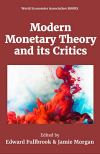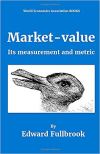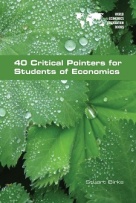At last – Paul Romer got his ‘Nobel prize’
from Lars Syll
Among Swedish economists, Paul Romer has for many years been the favourite candidate for receiving the ‘Nobel Prize’ in economics. This year the prediction turned out right. Romer got the prize (together with William Nordhaus).
The ‘Nobel prize’ in economics has almost exclusively gone to mainstream economists, and most often to Chicago economists. So how refreshing it is that we for once have a winner who has been brave enough to openly criticize the ‘post-real’ things that emanate from the Chicago ivory tower!
Adam Smith once wrote that a really good explanation is “practically seamless.”
Is there any such theory within one of the most important fields of social sciences — economic growth?
 Paul Romer‘s theory presented in Endogenous Technological Change (1990) – where knowledge is made the most important driving force of growth – is probably as close as we get.
Paul Romer‘s theory presented in Endogenous Technological Change (1990) – where knowledge is made the most important driving force of growth – is probably as close as we get.
Knowledge – or ideas – are according to Romer the locomotive of growth. But as Allyn Young, Piero Sraffa and others had shown already in the 1920s, knowledge is also something that has to do with increasing returns to scale and therefore not really compatible with neoclassical economics with its emphasis on decreasing returns to scale.
Increasing returns generated by nonrivalry between ideas is simply not compatible with pure competition and the simplistic invisible hand dogma. That is probably also the reason why neoclassical economists have been so reluctant to embrace the theory whole-heartedly.
Neoclassical economics has tried to save itself by more or less substituting human capital for knowledge/ideas. But Romer’s pathbreaking ideas should not be confused with human capital. Although some have problems with the distinction between ideas and human capital in modern endogenous growth theory, this passage from Romer’s article The New Kaldor Facts: Ideas, Institutions, Population, and Human Capital gives a succinct and accessible account of the difference:
Of the three state variables that we endogenize, ideas have been the hardest to bring into the applied general equilibrium structure. The difficulty arises because of the defining characteristic of an idea, that it is a pure nonrival good. A given idea is not scarce in the same way that land or capital or other objects are scarce; instead, an idea can be used by any number of people simultaneously without congestion or depletion.
Because they are nonrival goods, ideas force two distinct changes in our thinking about growth, changes that are sometimes conflated but are logically distinct. Ideas introduce scale effects. They also change the feasible and optimal economic institutions. The institutional implications have attracted more attention but the scale effects are more important for understanding the big sweep of human history.
The distinction between rival and nonrival goods is easy to blur at the aggregate level but inescapable in any microeconomic setting. Picture, for example, a house that is under construction. The land on which it sits, capital in the form of a measuring tape, and the human capital of the carpenter are all rival goods. They can be used to build this house but not simultaneously any other. Contrast this with the Pythagorean Theorem, which the carpenter uses implicitly by constructing a triangle with sides in the proportions of 3, 4 and 5. This idea is nonrival. Every carpenter in the world can use it at the same time to create a right angle.
Of course, human capital and ideas are tightly linked in production and use. Just as capital produces output and forgone output can be used to produce capital, human capital produces ideas and ideas are used in the educational process to produce human capital. Yet ideas and human capital are fundamentally distinct. At the micro level, human capital in our triangle example literally consists of new connections between neurons in a carpenter’s head, a rival good. The 3-4-5 triangle is the nonrival idea. At the macro level, one cannot state the assertion that skill-biased technical change is increasing the demand for education without distinguishing between ideas and human capital.
Paul’s idea about ideas is well worth a ‘Nobel Prize.’ Congratulations Paul!
































That’s pretty profound. When one takes theories of Endogenous money creation ( Keen et al ) one also needs to question the Scarcity of Financial Capital. A dangerous line of thinking this but I like it a lot.
Unfortunately this piece restates erroneous ideas prevalent in economic analysis:
Returns will ALWAYS be to scale unless there is a real underlying physical mechanism operating. Scaling relationships are well understood, Differences or similarities in the appropriate dimensionless numbers are significant. The speed of an object moving at Mach 1 is much greater at high altitude than at sea-level. Mathematical relationships MUST be dimensionally correct. Increasing or decreasing returns to scale formulations violate dimensional validity. I demonstrate this in my paper “Transient Development” in RWER-81 pp, 135−167.
Technical progress is most significant but the mathematics of growth described by Romer in his analysis based on the use of production functions violates dimensional validity. NO theory
is presented at all, ONLY equations fitted to concrete empirical data.
While the qualitative words are NOT wrong and, therefore, suggest plausibility, Their conversion to quantitative descriptions is simply nonsensical. Dimensional validity IS required. Until economists accept this without reservation, there can be NO progress in economics.
I cant see this is a telling or relevant critique of Romer’s statement. What on earth are “dimensionless numbers”? To numerise features of economics often requires heroic and tenuous assumptions!
Patrick Newman said “I can[‘]t see this is a telling or relevant critique of Romer’s statement.” It is in fact a total refutation of Romer’s growth theories!
It may have been better if I had used the term Dimensionless Quantity. Examples range from refractive index and relative permeability, being simple concepts, to more complicated examples such as the Mach, Prandtl, Reynold’s numbers etc.
Dimensionless quantities are described in Wikipedia. They relate complex interactions in a meaningful manner.
If you had read my paper which I referenced you would have understood why quantities have to have small integer exponents. Production functions do not have small integer exponents. Their use implies curve-fitted relationships NOT abstract theoretical relationships which I believe is implied by your final sentence, though I reject the assertion made.
This is an interesting exchange of views , the blog that followed this one also engages with the question.
In the Fourier Transform there are two domains the Time domain and the frequency domain I think as a real world analogy for Franks “dimensionlessness” The frequency domain is perhaps a useful four dimensional metric with subtleties reflecting multi dimensional non coupled phenomena. The time dimension in digital Signal processing is two dimensional and linear and simply does not capture the complex action of frequency interactions which are far more complex.
This is a simple geometric explanation of the frequency domain.
Another interesting insight into symbiosis and cooperation and mutuality as a positive strategy as an alternative to competition if the work of Martin Nowack an evolutionary biologist.
https://www.whyarewehere.tv/people/martin-nowak/
MN: Yeah, let us start the game. And we see, yes, these defectors, they are spreading, you know. So the colours that we are observing here are: red are defectors and blue are co-operators, and yellow and green are changing sides.
So yellow is now a new defector: it was a co-operator before. And green is a new co-operator: it was a defector before. We see the pattern is spreading. A kind of symmetry is being maintained here because they are deterministic of the rules, and the initial symmetry is never broken. But the amazing thing is these co-operators, they are persistent. They just refuse to get wiped out and they survive in those clusters. And if you watch very carefully, you see the clusters, they are actually growing until they collide with other clusters, and then they’re shrinking, and then they grow.
David: But they never go out of business.
MN: But they never get out of business. And the amazing thing is the average abundance of co-operators in this pattern is very close to 12log2-8.
David: What does that mean?
Ard: It’s close to constant.
MN: It converges to a constant which is approximately 31%, and this is a mathematical curiosity. ( QED)
Professor Sir James Mirlees RIP. Sadly James passed away in September, this keynote has stayed with me since I first heard it, he makes some profound insights into the Language of Mathematics.
https://www.telegraph.co.uk/obituaries/2018/09/04/professor-sir-james-mirrlees-nobel-prize-winning-economist/
Roger, your three comments are much appreciated. See my reactions to them under “The necessity and difficulty of shifting our paradigms. Besides totally agreeing with Mirlees’ hurried practical conclusion, I started with his truth table (i.e. with communication processes having to account for “lemons”) and saw the separation of variables as in broadband as instances of Nash equilibrium. (Not what Nash as a mathematician was looking for, but then I was trained as an engineer, defined by trying to “make for 6d what any fool can make for a pound”).
https://rwer.wordpress.com/2018/10/10/stiglitz-vs-summers/ I have now found the circuit point.
As an irregular reader here the flow of debate is absent my palette as it were.
I regularly read Dr Tim Morgans blog and think his SEEDs measure of prosperity related to surplus available energy lends itself much better to circuits of resources and commodities measured in Energy rather than abstract monetary measures.
Thank you David, the world was in my view a better place when run by engineers rather than financial engineers.
It’s always appreciated when an engineer encourages ones line of reasoning. I read your comment below and agree with your points. Regarding Gestalt and Dyslexia Focaults definition of the Episteme is on point and Polyani made much the same sort of criticism of policy led evidence making in The Republic of Science.
Have a great weekend,
Roger
It is astonishing that Lars Syll is welcoming Paul Romer’s Nobel Prize winning with his all heart. Even Romer criticized some aspects of mainstream economics (“post-real economics” and “thirty-year degradation of macroeconomics), he is a true neoclassical economist. His main work called Endogenous Growth Theory totally depends on the notion of aggregate production function (most often of [modified] Cob-Douglas function). This notion (Cob-Douglas production function in particular) has been criticized since long time, by Anwar Shaikh (1974), H.A.Simon (1979), and many papers of Jesus Felipe and John McCombie. It represents a symbolic tool which almost all mainstream macroeconomics use and without which most of their economics break down. Romer modified a bit the way to use this production function, employing two or three new ideas for input variables. If Romer’s theory or models are not neoclassical, where ca we find neoclassical macroeconomics papers? Lars Syll is ‘dazed and confused’ by the term “knowledge” and thinking that Romer is a little different.
The Lars Syll’s post reveals how his methodology (mainly around openness [of the system}, uncertainty, and based on critical realism) has no real power to criticize real neoclassical economics. His repeated “criticism” is only an attack against strawman enemy.
Readers of this blog are requested to compare Lars Syll’s post with similar contribution by John T. Harvey which appeared in Forbes October 8th:
The Nobel Prize And Keeping Economics Real
https://www.forbes.com/sites/johntharvey/2018/10/08/the-nobel-prize-and-keeping-economics-real/
If readers do not read this with care, you may think this is quite similar to Lars Syll’s post. But Harvey’s is a backhand compliment. Many compliments are in fact arranged to show how the present-day mainstream economics is intellectually rotten. It is a shame that Lars Syll could not use this occasion as beautifully as John Harvey.
Thanks for this. Indeed Harvey’s is a revealing commentary, quite unusually honest.
All I can see is confusion over numbers, characters and prizes! If mathematics and philosophy are in any way related at all, if expressions of numbers, concepts must take place in human languages, what prizes are these Nobleman winning? No disrespect to Paul, of course, as I am sure he must have gone against the mainstream tides many times to get where he is. But, I do wonder what has happened to this year’s winner of the Noble price for literature? The last time I double checked, the ceremony seemed to have been postponed? And does this mean we are back to abstract maths again, or just binaries of zeros and ones? Or, perhaps even the circular mass of continues patterns, which Western scientists have discovered recently could (just a small possibility) be the answer to the creation of the universe itself? I remain stunned by it all. Perhaps we can go back to Newton and Einstein again.
I understand that the Literature Nobel has been postponed to next year because of sexual assault scandals involving Nobel panellists. There will be two prizes next year.
Roger Lewis says “The time dimension in digital Signal processing is two dimensional and linear and simply does not capture the complex action of frequency interactions which are far more complex”.
More to the point, it separates the varying signals and thus avoids their complex interactions (which incidentally were discovered in long-distance telegraphy, where it was found low frequency sounds travelled faster than high frequency sounds, tending to catch these up and muddle them). See what I wrote about separating the money circuits in my reply to Peter B. on Stiglitz vs Summers. But that’s low frequency stuff – a design criteria rather than day-to-day management stuff – and if listened to would leave all Yoshinori’s mainstream “Cobb-Douglas” irrelevance behind. Romer is entitled to have new as well as mainstream ideas, though outside of economics this one is called common sense.
The mainstream of course responds to new ideas leading to growth of rival mainstreams: by obfuscation, ad hominem attacks on new thinkers, trying to buy up or bankrupt developers, and commercial secrecy. Though obfuscation can be deliberate, the stories of gestalt and dyslexia suggest it can be due to cognitive dissonancce, i.e. objecters confusing themselves because they haven’t yet seen the young lady’s face in Asad’s old crone. The remedy for dyslexia is apparently to practice seeing things from different points of view.
https://rwer.wordpress.com/2015/07/07/euro-the-antithesis-of-democracy/ I think I found the discussion you refer to davetaylor1 ( Dave or David?) I could not find the separating monetary circuits point although I think we are on the same page. As applied to competition theory I like Martin Shubics view on money given here.
Martin Shubik,
”The monetary and financial system of an economy are part of the socio-politico-economic control mechanism used by every state to connect the economy with the polity and society. This neural network provides the administrative means to collect taxes, direct investment, provide public goods, trade. The money measures provide a crude but serviceable basis for the accounting system which in turn, along with the codification of commercial law and financial regulation are the basis for economic evaluation and the measurement of trust and fiduciary responsibility among the economic agents. A central feature of a control mechanism is that it is designed to influence process. Dynamics is its natural domain. Equilibrium is not the prime concern, the ability to control the direction of motion is what counts.
Money and financial institutions provide the command and control system of a modern society. The study of the mechanism, how they are formed, how they are controlled and manipulated and how their influence is measured in terms of social, political, and economic purpose pose questions, not in pure economics, not even in a narrow political economy, but in the broad compass of a political economy set in the context of society. ”
Martin Shubik
https://www.nytimes.com/2018/08/31/obituaries/martin-shubik-dead.html I see we lost Martin also in August like Mirlees.
https://longhairedmusings.wordpress.com/?s=Usury+shubik
Perhaps Paul Romer will demonstrate the intellectual integrity he calls for and embrace an idea that comes from outside the Economics profession. http://instituteforfinancialtransparency.com/2018/10/08/intellectual-honesty-and-economics/
Thank you Geoff for the comment on the postponement. Let us see what other scandals will emerge by next year. We have a long and sensitive year ahead. Personally, I hope that Nigel Lawson is allowed to stay in France permanently! It is a shame that he had to be exposed. I admit that I never had much respect for his Lordship, but his revelation that: “…Brexit is not about me…Most British People live in GB…” did make me stop crying temporarily for all the chaos, confusion that such people have caused for centuries. Perhaps he (and others like him) will be gracious enough now to grant the unknown number of asylum seekers that they have used as slave labour for decades, permission to stay permanently? Just to continue with their servitude, after all none of them are British! Moreover, they never left their homelands voluntarily.
To humanise Economics, we must humanise our models.
Sorry to join this thread late. There isn’t any need to invoke Fourier transforms to explain the dimensional predicament of Cobb-Douglas production functions. Simply look at the original Cobb & Douglas paper (1928). You’ll see that the quantities of labor, capital and output were each normalized to their values in 1899 (the “base year”). Consequently, those variables were dimensionless in the original equation, which was intended as an empirical fit to historical data.
The problem with modern growth theory expositions of Cobb-Douglas functions is that the authors either ignore dimensions and normalization altogether (more usual), or else ascribe dimension-bearing units to each of the variables. Solow’s 1957 paper mentions that the variables Q, K and L represent output and the capital and labor inputs “in ‘physical’ units.” His textbook on growth theory (2nd ed. 2000) also ascribes physical units to the variables. So does Romer’s 1990 paper, particularly in regard to equation (6). All these ascriptions lead to significant problems with dimensional balancing, For more detail, see, e.g., the textbox at pp. 14-15 in my working paper “Unlimited Growth and Innovation: Paradise or Paradox?” (2010) https://www.ssrn.com/abstract=1709285 .
Another feature of Romer’s theory is that, far from demonstrating that “ideas” can lead to unlimited growth, it assumes they can. Romer (1990) admits this, at S84: “[U]nbounded growth is more like an assumption than a result of the model.” This is an understatement. One of the culprits is his equation (5), which posits that the number of designs increases exponentially simply as a function of time. Another is his assumption that each new design will get turned into a product that gets sold, thereby pumping up output Y.
Given the built-in circularity in Romer’s work, it doesn’t speak well for the Bank of Sweden committee that they thought it a significant discovery. Speaking as an intellectual property lawyer active in patent work during the 1990s, and as a transactional lawyer active in Silicon Valley during the dot-com period and into the current century, it’s clear that Romer’s assumptions have nothing to do with the realities of patent law, nor with the way real firms use their patent portfolios. Rather, his optimism and the hype around it were simply well-suited to the mood of the dot-com era — and evidently, a nostalgia for those “good times” that has lingered long enough for him to get his prize.